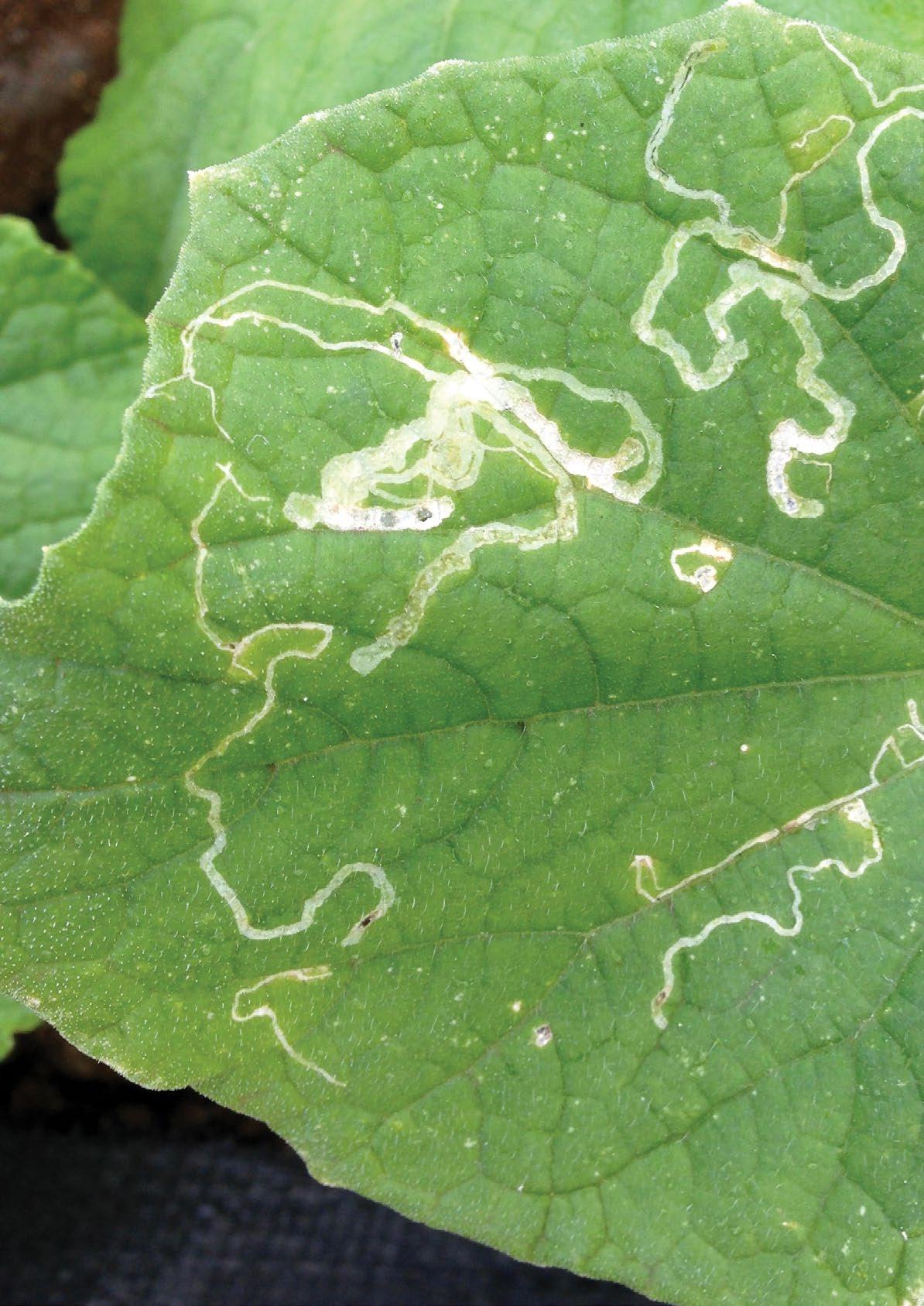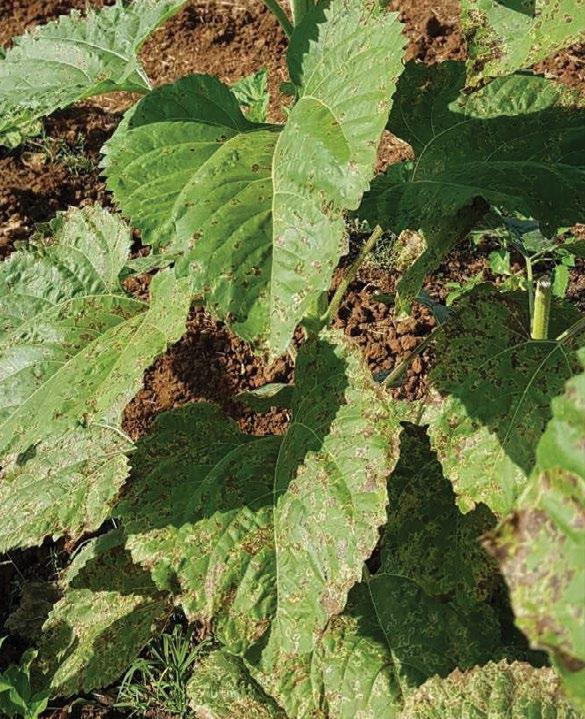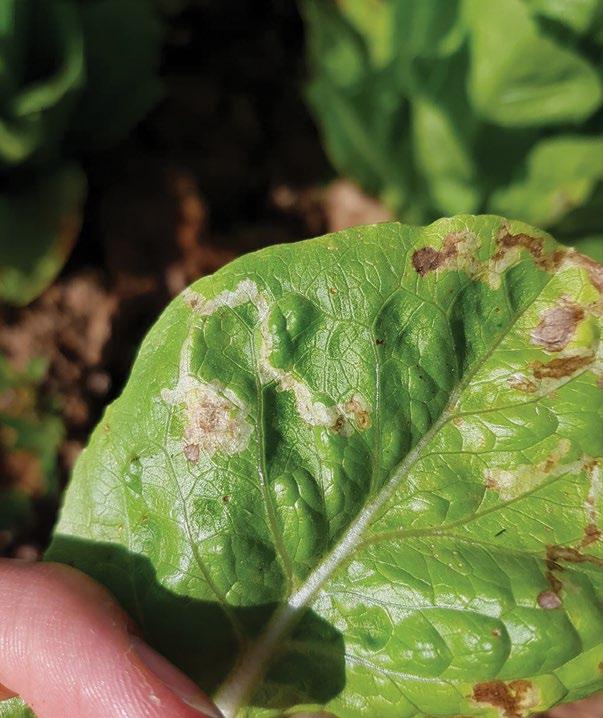
6 minute read
American serpentine leafminer
f AMERICAN serpentine leafminer larvae damage can be identified by twisting white patterns on the leaf surface, caused by the tunnelling or 'mining' activity.
Advertisement
The Department of Primary Industries and Regional Development (DPIRD) has been responding to the detection of American serpentine leafminer in Kununurra since July 2021.
This is the first time American serpentine leafminer has been detected in Australia.
Following the detection, DPIRD conducted surveillance in Kununurra, Broome, Carnarvon, and Geraldton to determine the distribution of the pest. Surveillance confirmed the presence of the pest in Broome. There have also been detections in the Katherine region of the Northern Territory and in Queensland — on Thursday Island in the Torres Strait and in the Northern Peninsula Area of Cape York Peninsula.
DPIRD Chief Plant Biosecurity Officer Sonya Broughton said this pest was considered a national priority plant pest as it posed a serious threat to Australia’s horticulture, nursery production, and agricultural plant industries. She said DPIRD was preparing awareness and information material to assist industry manage the pest where established. “American serpentine leafminer are small flies whose larvae feed internally on the leaves of plants. Severe infestations may result in premature leaf drop, poor growth, and reduced crop yields,” Dr Broughton said. “This pest has a wide host range of more than 400 species of plants which includes beans, celery, chrysanthemum, cucumber, gerbera, gypsophila, lettuce, onion, potato, tomato, peanuts, soybeans, lentils, faba beans and chickpeas. “There are a number of native leafminer species present in Australia, but most are very host specific and do not impact horticultural production.”
Feasibility of eradication
Dr Broughton said the entry pathway of this exotic pest into Australia was unknown. It may have arrived in Kununurra on plant material, but wind dispersal from seasonal monsoon winds in northern Australia was also a possibility. “No properties are likely to be quarantined as part of DPIRD’s response. At this point, our priority is to carry out American serpentine leafminer has a wide host range of more than 400 species of plants. surveillance to determine the presence and spread of the pest, and to provide management options to minimise any impact,” she said. A final decision on the feasibility of eradicating American serpentine leafminer is yet to be made. The national technical committee, the Consultative Committee on Emergency Plant Pests, met to discuss the detections and agreed that further information was needed before making any final recommendations.
The Kununurra detection was initially made in a cotton crop, and on coatbuttons and wild gooseberry weeds. On Thursday Island it was detected in Cinderella weed.
The Kununurra and Queensland detections were made during routine plant health surveys by North Australian Quarantine Strategy (NAQS) officers.
f AS the mines age, the leaf surface becomes necrotic (brown).


f AMERICAN serpentine leafminer damage on a sunflower plant in Kununurra.
“Due to the pest’s biology, current distribution and wide host range, it is unlikely that eradication would be technically feasible. Although there may be measures that can be taken to delay its spread,” Dr Broughton said. “The committee has agreed that more surveillance and diagnostic data is required before making a final decision.” Surveillance is still being conducted to determine the distribution of this pest. Dr Broughton said DPIRD will continue to work closely with all stakeholders to minimise the impact of this pest on WA growers, including growers in the Ord River area, Broome, Carnarvon and Geraldton, industry stakeholders, the Commonwealth Government, and other States and Territories.
More about American serpentine leafminer
Damage
• Damage is caused primarily by larvae feeding under the surface of leaves, and tunnelling (mining) within the leaf tissue. • Leaf damage also occurs through puncture wounds from the adult feeding and depositing eggs. • As the mines age, the leaf surface becomes necrotic (brown). • Tunnelling can affect the plant’s ability to photosynthesise, reducing plant growth and crop yields. • This pest is particularly a problem in protected cropping systems. • Plants can be affected during all growth stages.
Treatment and management options
Identification
Dr Broughton said DPIRD was working closely with other states including Queensland and New South Wales, to look at management options based on research into other species of leafminer detected in Australia. “American serpentine leafminer is known to develop chemical resistance. We will be sending specimens to New South Wales to assess their insecticidal resistance, to inform any chemical control recommendations,” she said. “In the meantime, growers should refer to the existing permits for treating exotic leafminer species, including American serpentine leafminer.”
• American serpentine leafminer can be confused with other Australian native and introduced Liriomyza species. •Definitive identification of American serpentine leafminer is known to develop chemical resistance. adult flies requires male specimens, whereas immature stages must be analysed by molecular methods to confirm species. • Adult flies are small, yellow and black. • The larval stages are not usually seen as they remain inside the leaf tissue. • An infestation would most likely be detected through the presence of the mines on leaf surfaces, which are evidence of larvae presence.
Information on suitable insecticides is available from the Australian Pesticides and Veterinary Medicines Authority website (portal.apvma.gov.au/permits).
Dr Broughton said insecticide treatments will need to incorporate resistance management strategies to be effective.
"Additionally, consider the use of pesticides that favour beneficial insects. Overseas, management of leafminers includes the use of natural enemies, such as parasitoids that attack larvae.” What to look for
• Trails (mines) on leaf surfaces, which look like light green-white squiggles. Trails get wider as the larvae grow. • Fungal and bacterial infection, which may occur as the feeding damage increases susceptibility to secondary infections. • Brown and dead leaf tissue, as leaf surfaces become necrotic when the mines age. • Trails may be indistinguishable from the damage of other leafminers — so report any damage, even if unsure. Spread
The American serpentine leafminer is widespread overseas, including North and South America, Asia, Africa, Europe and some Pacific islands.
The pest can be spread through the movement of plant material, soil, clothing and equipment. The adult can also spread short distances either unaided or assisted by the wind.
What you can do
• Production nurseries, growers and backyard gardeners should check crops regularly for signs of pests and diseases. • Report any leafminer damage or suspect flies to DPIRD, particularly if on more than one type of crop/plant. • DPIRD is asking for reports of both presence and absence of damage/flies. • Always ‘Arrive clean, leave clean’ by implementing on-farm biosecurity practices to prevent pest and disease incursions. • The farmbiosecurity.com.au website has helpful information that can be tailored to your property.
MORE INFORMATION
Refer to the DPIRD website agric.wa.gov.au/ american-serpentine-leafminer for up-todate information, including any domestic trade related updates. Although the pest impacts a significant range of host plants and species, it is present across large areas of Africa, Asia, Europe and the Americas. This suggests international trade issues are likely to be limited. Australian exporters will be notified by the Department of Agriculture, Water and the Environment should importing countries change their requirements.
Report your observations!
MyPestGuide™ Reporter via online or app mypestguide.agric.wa.gov.au
Pest and Disease Information Service (08) 9368 3080 padis@dpird.wa.gov.au










